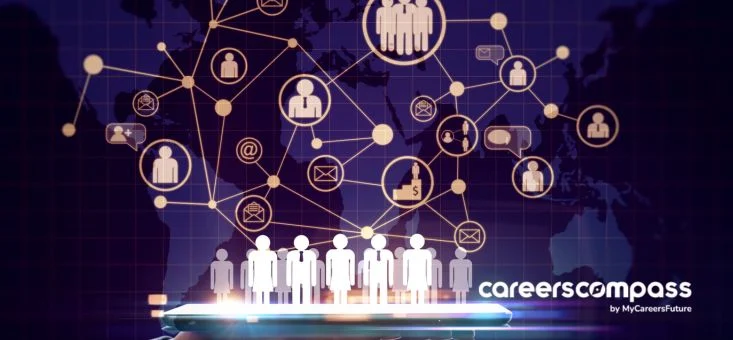Many articles discuss the latest HR trends and how business owners, CHROs and HR directors must evolve in this ever-changing business landscape. Some include the need for companies to embrace inclusivity and diversity in hiring, flexible working arrangements, mental health and employee engagement, and new ways of maintaining company culture in a hybrid work environment.
All these functions are important, but not all HR departments have the time or manpower to focus on these issues, especially SMEs. Nonetheless, even SMEs can start by prioritising and gaining small wins by tapping into technology and job redesign to improve HR productivity.
How are HR roles affected by technology?
The Jobs Transformation Map for HR has identified key trends impacting HR. Eight job roles, all administrative in nature, will be significantly impacted by technology, and another 16 job roles will experience a moderate level of impact and require updated skills to support strategic functions.
The roles most exposed to significant impact are those at the Associate and Executive levels. As many of their current responsibilities involve administrative tasks, they are more susceptible to automation and at risk of redundancy. This is attributed to technological advancements such as robotic process automation (RPA), machine learning and social robotics. To stay relevant in the future, HR professionals in these roles will need to upskill to deliver higher-value work and identify ways to contribute to the business transformation.
The roles poised for a moderate level of impact are at the Manager and Head levels, and they will be augmented by technology. These roles will require expertise in applying technology-driven service delivery solutions and utilising data analytics to support strategic functions, including capacity planning, building future capabilities, and enhanced talent experiences to build an agile workforce.
How can Job Redesign help?
In a recent Job Redesign study by Workforce Singapore (WSG), 65% of the companies acknowledge that Job Redesign involves adopting new technologies that can improve productivity, and 63% of the companies understand that Job Redesign can help improve the quality of job roles.
If you are unsure how to redesign your company’s HR roles, WSG’s Human Resources Job Redesign Initiative (HR-JR) could be the answer. Companies can work with WSG’s pre-approved consultants and receive funding support for job redesign-related consultancy costs through the Support for Job Redesign under the Productivity Solutions Grant (PSG-JR).
Companies can also seek support for their HR professionals in undertaking redesigned HR roles through WSG’s Job Redesign Reskilling Career Conversion Programme for Human Capital Professionals (JRR CCPs). The JRR CCPs support companies in identifying vulnerable job roles due to business transformation plans and equip them with the required knowledge and new skills to take on higher-value or redesigned roles.
Tapping on government initiatives like these can help companies take the first step and make the journey of digitalisation and automation more accessible.
Digitalise and automate to elevate HR’s role
HR work is diverse, covering recruitment, talent management, employee engagement, training and development, compensation and benefits, and more. This often overwhelms HR professionals with administrative and process-driven tasks, with little time to focus on strategic work like employee engagement. In a small company setup, employees could be wearing multiple hats, with HR being just one of them.
This is especially true for SMEs where the HR team consists of just one or two employees overseeing the entire function.
The era of HR solely focusing on recruitment and payroll has evolved significantly. HR departments are now expected to take on business partnering and workforce planning that directly impact a company’s growth and sustainability. Companies must embrace technology adoption and job redesign to empower HR professionals to fulfill their roles effectively, and devote additional resources to resolving various employee concerns.
“To empower HR professionals to fulfill their roles effectively, companies must embrace technology adoption and job redesign.” – Gillian Woo, Director, Creative & Professional Services, at Workforce Singapore
Uses of tech in HR include:
- Applicant tracking systems help sieve through resumes.
- RPA automates routine tasks like processing timesheets.
- Increased use of intelligent automation and predictive analytics will also support data-driven talent acquisition decisions and enable automated service delivery.
- Employee engagement initiatives harness technology for better collaboration, communication, and feedback loops, fostering inclusivity and motivation.
- Performance management benefits from data-driven insights, enabling fair evaluations and targeted development plans.
- Learning and development programmes incorporate e-learning platforms, gamification, and virtual reality to offer interactive and continuous training opportunities.
- Automating administrative tasks such as payroll processing, leave management, and benefits administration reduces manual errors and frees HR professionals to focus on strategic initiatives.
- Chatbots, now designed to be conversational and can attend to many simultaneously, can respond promptly to common employee enquiries such as staff benefits, relieving HR of such recurring tasks.
At HRM Asia’s HR Tech Fest held in May 2023, there was a showcased AI chatbot that could conduct pre-screening by asking applicants a few questions, shortlisting potential candidates and even auto-schedule interviews based on the hiring manager’s availability! Imagine how this helps free up HR’s time to respond quickly to job applicants, which is crucial in today’s competitive talent market.
Reducing routine and time-consuming tasks is the first important step towards a more productive HR team. This time-saving approach enables HR to focus on strategic matters. The ripple effect extends to business owners and CHROs, who can now re-evaluate job roles and develop employees to take on higher-value functions.
Will AI and tech replace human HR?
Some may wonder if AI and tech will completely replace HR and if large language models like ChatGPT will eliminate the recruiter. My take is no. While technology will reshape job roles, human resources will have to evolve to incorporate the management of technology and the intelligent use of data for better decision-making, moving from basic data analytics to predictive analytics and modelling. Ethical and fair hiring practices will be crucial when using these systems.
Most importantly, the human touch will remain indispensable to ensure a positive employee experience.
According to Willis Towers Watson’s global study with the World Economic Forum on Shaping People Strategies in the Fourth Industrial Revolution, technology trends will lead to the re-invention of HR’s future role to shift toward driving business transformation and productivity. This will involve continuous investment to enhance jobs, encourage continuous learning and reskilling, and use advanced and predictive analytics for strategic workforce planning and transformation.
Technology will play a pivotal role in enhancing talent attraction and retention. Notably, the ability to establish data connections between talent and business metrics will offer deeper insights into identifying and retaining talent. This approach helps eliminate inherent biases and cultivates a diverse and skilled workforce. If you have any in your company, the time to redesign HR roles and upskill these staff is now.
This article was originally published on HRM.















